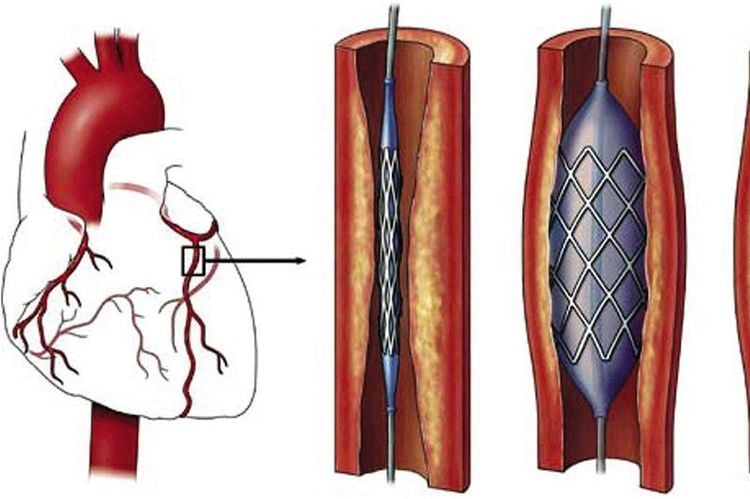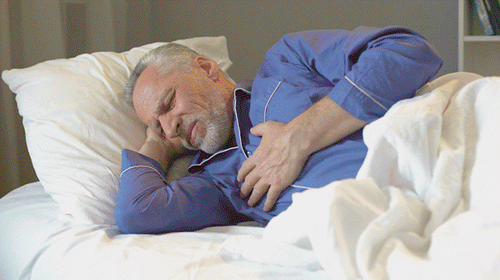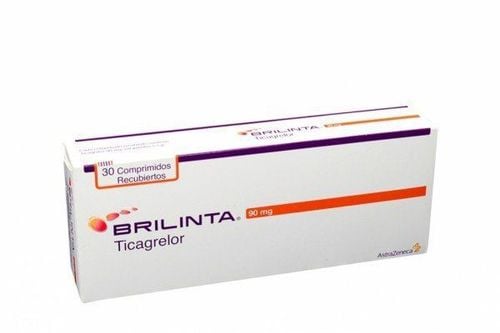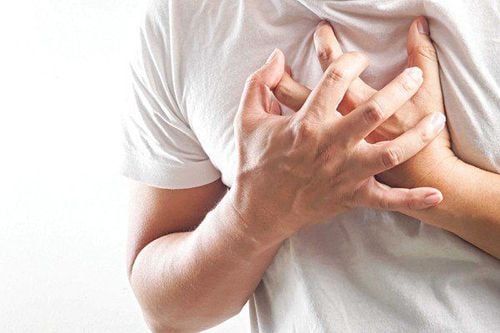This is an automatically translated article.
Coronary stenting helps to limit the re-stenosis of the coronary arteries and improves the patient's quality of life. After stenting, the patient needs to continue taking the medications as prescribed by the doctor.1. Do patients who have had coronary stents need to continue taking medication and which drugs are they?
Coronary stenting is indicated when coronary artery stenosis occurs. During the procedure, the doctor inserts a needle in the patient's wrist or groin, then inserts a small catheter into the narrowed coronary artery. Next, the doctor threaded a small metal wire into the catheter, through the narrow blockage, deep into the vessel. The stent system will slide up this metal wire, into the correct position of the narrow blockage. The balloon of the stent is inflated, expanding the stent, pressing the plaque against the artery wall, widening the lumen. Drug-eluting or non-medicated stents are used on a case-by-case basis. After stenting, the patient will find that the angina pain is reduced, the body is more comfortable, and the ability to exercise is increased than before.Coronary stents help reduce the risk of re-stenosis, improve patient quality of life and reduce hospitalization for coronary heart disease. However, stents do not completely replace medication. On the contrary, after placing a stent, especially a drug-eluting stent, the patient needs to strictly follow the doctor's instructions on taking the drug.
Essential drugs for patients with coronary stents can be listed as:
Antiplatelet drugs: Aspirin, Clopidogrel. Stent is a foreign object to the body, if antiplatelet drugs are not used, it is easy to create blood clots, causing embolism - a dangerous complication with high mortality rate Lipo-lowering drugs ACE inhibitors Beta-blockers Patients should be aware that abrupt discontinuation of the drug can lead to particularly serious consequences, even death. Patients need to have regular health check-ups to be prescribed the right medicine, monitor and treat the side effects of the drug.
MORE: After coronary stent placement, what should patients do to get good results?

Việc chăm sóc sau đặt stent mạch vành giúp người bệnh nhanh chóng hồi phục
2. Guidelines for care/health management after coronary stenting?
After coronary stent implantation, patients in addition to complying with medication use need to pay attention to care to recover quickly. Accordingly, the care and health management after coronary stenting is applied as follows:2.1 Incision care After the procedure, there will be a small hole in the skin of the brachial radial artery or femoral artery. . The patient will be bandaged for 12 hours for the radial artery or 24 hours for the femoral artery. During that time, the patient should limit the movement of bending and stretching at the incision to reduce the risk of bleeding.
Medical staff will moisten first to remove the bandage on the wound, then rinse with physiological saline or antiseptic solution, can be bandaged or allowed to breathe. Care should be taken to wash the wound at least once a day with saline or antiseptic solution, then gently wipe it with a soft cloth. At the same time, the patient should try to keep the wound dry; do not apply creams or ointments to the wound; wear loose clothing; Do not bathe or swim for 1 week after the procedure. After the intervention, patients should rest absolutely for 1 week, then gently exercise.
Note to patients with brachial artery catheterization:
Do not use wrist to lift weight over 900g within 24 hours after stenting; Within 2 days after the procedure, do not exercise strenuously, even with games such as badminton, tennis, golf,...; Within 2 days after the procedure, do not work with tools that require high precision and hand flexibility such as driving, using sharp objects, ... Note to patients with femoral artery catheterization:
Do not walk or exercise too much to avoid bleeding in the thigh wound; For 5-7 days after the procedure, do not lift or push anything heavier than 4.5kg; For about 5 days after the procedure, you should not do any strenuous exercise, including fun activities; Patients can climb stairs after stenting but should walk slowly; After 1 week of stent placement, the patient should gradually increase the time and intensity of exercise. Other important note:
Before returning to work it is necessary to consult a doctor. Usually, after about 1-2 weeks of the procedure, the patient can return to normal work. However, the recovery time for patients with myocardial infarction will be longer; Should walk short distances, limit climbing stairs; Do not do heavy or overworked work; If the incision site is swollen or bleeding, the patient needs to lie down, press his hand on the wound for about 30 minutes to stop the bleeding; If the incision is oozing pus, you need to go to the doctor immediately to treat the infection, to avoid the risk of complications. 3.2 Re-examination on time After discharge, the patient will be prescribed medicine to continue treatment. Patients need to strictly adhere to taking the drug to achieve the best therapeutic effect.
Re-examination time should be 1-3 months/time. If there are abnormal symptoms such as black stools, increased chest pain, shortness of breath, dizziness, nausea, bleeding under the skin, limitation of exercise, ... then it is necessary to immediately re-examine. At that time, the patient will be tested for heart function, platelet count, blood clotting function test, ...
Besides, the treatment needs to be coordinated between specialties. In particular, patients after coronary stent implantation need to closely control blood sugar and blood lipid disorders to reduce the risk of coronary re-stenosis.
MORE: Diet after coronary artery disease surgery to avoid coronary re-stenosis

Ngoài chăm sóc sau đặt stent mạch vành người bệnh cần được khám sức khỏe định để kiểm soát bệnh
Protein: Patients should eat moderate amounts of eggs, lean meat, skinless chicken, tofu. Each week, patients should eat 2 fish meals such as mackerel, salmon, sardines, ... to provide Omega-3 for the heart. In addition, it is necessary to avoid red meat such as dog meat, beef, ... to avoid increasing cholesterol, easily causing coronary atherosclerosis; Fiber: Add to the menu green vegetables and fresh fruits, especially colorful vegetables; Fat: Use unsaturated fats like vegetable oils (sunflower oil, canola oil, olive oil) or nuts, fish oil, avocado. At the same time, patients should minimize animal fat and skin, limit fast food; Water: Drink plenty of water (except for patients with severe heart failure) and limit sugary drinks and stimulants. Patients should drink 8-10 glasses of water/day to remove contrast material used during coronary intervention. In addition, the patient should drink more low-fat milk, unsweetened milk, yogurt or soy milk; Should eat lighter than the average person to avoid the risk of hypertension, edema; Quit smoking, don't be exposed to secondhand smoke; Exercise - regular sports with gentle movements; Avoid going out in cold weather. Coronary heart disease is a disease with a high risk of death. Coronary stenting is an effective treatment, increasingly widely applied. Patients and family members need to pay attention to the care after coronary stenting, especially to adhere to the use of drugs to avoid complications, limit coronary re-stenosis, and reduce the risk of death.
Coronary re-stenosis can occur if the patient with coronary stent does not follow the instructions on drug use, nutrition, and exercise. Therefore, in order to ensure health, after coronary stenting, patients need to continue to use drugs as prescribed, and at the same time pay attention to incision care, maintain appropriate nutrition, and schedule follow-up visits to ensure health. Prevention of possible complications after coronary stenting.
Cardiovascular Center - Vinmec International General Hospital is effectively and safely applying coronary angiography, balloon angioplasty, angioplasty and coronary stenting. Accordingly, after the coronary stenting process, the patient is also monitored, managed and given intensive advice on how to care for, manage and maintain an appropriate diet to recover quickly.
The entire procedure of examination and treatment, coronary intervention at Vinmec is carried out by a team of qualified, experienced and well-trained medical doctors, so it brings good treatment results, limited Reduce the risk of restenosis after coronary stenting.
Please dial HOTLINE for more information or register for an appointment HERE. Download MyVinmec app to make appointments faster and to manage your bookings easily.













